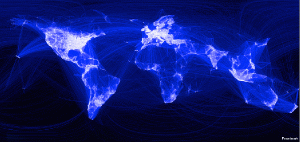By Jessie Kastenbaum (jekastenbaum@vassar.edu)
As technology progresses, the world becomes more connected and communication improves dramatically. Wu’s The Master Switch follows the progression of communication technology starting with the telephone, going to the radio, then to film, and so on. With each new device, people become more connected to each other and are able to communicate in different ways. The telephone allows two people to hear each other across distances. The radio allows people to hear multiple types of media, from talk shows to music to presidential speeches from remote locations. With film, viewers can see and hear stories come to life. Wu mentions “the power of an open technology like radio broadcasting to inspire hope for mankind by creating a virtual community” (39). The first thing that springs to my mind when I think of a “virtual community” is the Internet, and YouTube in particular.
Through the Internet, we can share information and ideas with anyone else in the world who also has access to the Internet. This map, which shows the global connections via Facebook, illustrates just how connected the world is via the Internet:
This connectivity is extremely apparent on YouTube where an enormous community of video bloggers, or vloggers, has sprung up. Many people think of YouTube as just a site for video clips of adorable kittens and of people running into stop signs. However, there is so much user-generated content that goes unnoticed by the greater public. Audiences interact with vloggers through comments and making video responses. In addition to interaction between vloggers and their audiences, there is a great deal of interaction among vloggers. Most of the vloggers I watch are members of the same YouTube community, called Nerdfighteria. Nerdfighteria began when two brothers, John and Hank Green (the “vlogbrothers” on YouTube), began a vlogging project in which they would communicate without text for an entire year. They built up an audience around their vlogs and call themselves and their audience “nerdfighters” (because we fight for nerds and fight to decrease world suck, which is exactly what it sounds like). Here is one of John’s vlogs (which actually talks about community a bit):
Many of the vloggers of Nerdfighteria are friends through YouTube and through this community. The community has brought people together from around the globe, showing the connective power of the Internet and YouTube. One of the best examples of the YouTube community is the “collab channel.” A collab channel is a YouTube channel run by multiple people; typically, each person posts a video one day a week. For example, on the channel FiveAwesomeGirls each of five girls posts one video on a specific day of the week. Kristina posts on Mondays, Lauren on Tuesdays, Kayley on Wednesdays, and so on. The five girls do not live near each other and did not know each other personally before they began their collab channel, but have become close friends through the YouTube community.
Something I have noticed about video bloggers is that they tend to use similar techniques. For example, they usually use a lot of jump cuts, something that is frowned upon in movies. Why do vloggers use jump cuts? It could be because they simply can’t remember everything they have to say to do the vlog in one take, or it could be that it makes the video more visually interesting. After all, most vloggers are just talking to a camera, so they need to do something to hold their viewers’ attention. Furthermore, most popular vloggers use a lot of hand gestures. Again, this could be to make their videos more interesting or it could be to help get their points across. Here is a video from one of my favorite vloggers, Charlie McDonnell (“charlieissocoollike” on YouTube):
What do you notice about John and Charlie’s videos? Why are they interesting (or why aren’t they interesting)?
Wu mentions the “mix of both entrepreneurial and humanitarian motives” that “drives the opening up of a media” (36). YouTube is primarily humanitarian—vlogging is generally not an economically sound job (although you can earn money from running ads on your videos). Most vloggers make videos because they genuinely love doing so and have a message they want to share with the world.
There are so many different communities on the Internet—the YouTube community is just the one with which I am most familiar. Furthermore, the Internet is just the next step in connectivity. According to Wu, “what we call invention, while not easy, is simply what happens once a technology’s development reaches the point where the next step becomes available to many people” (19). Connectivity and communication will thus continue to increase as technology improves. There is an exceptional amount of global connectivity due to the Internet, but can we improve on it? What will be the next step? Can the world become even more connected than it currently is? Can we continue to build our global community?

